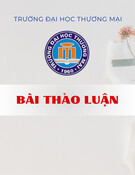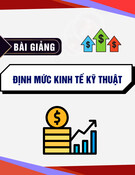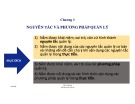
Managerial Economics – MBA – HSB – Huy Nguyen, 9/2020
[Type here]
Homework 2
OPTIMAL DECISIONS USING MARGINAL ANALYSIS
Multiple Choice
M1 A firm’s total cost function is given by: C = 1,000 + 15Q. At an output of 200 units,
a. Total cost is $4,000 and marginal cost is $3,000.
b. Total cost is $3,000 and fixed cost is $1,000.
c. Total cost is $4,000 and marginal cost is 15.
d. Average total cost is constant.
e. Answers c and d are both correct.
M2 A firm’s price and cost equations are given by P = 200 - 2Q and C = 1,000 + 40Q, respectively.
Therefore,
a. The firm’s revenue is: R = 200 – 2Q2.
b. The firm’s profit is: π = -1000 + 160Q – 2Q2
c. The firm’s revenue is: R = 200Q – 2Q2.
d. At Q = 50 units, the firm’s total profit is 2,500.
e. Answers b and c are both correct.
M3 A firm’s cost equation is given by C = 200 + 10Q + 2Q2. At Q = 20, marginal cost is
a. $1,200
b. 1,200/20 = $6
c. $1,000
d. 1,000/20 = $5
e. $90
M4 If fixed costs increase, what will happen to marginal revenue and marginal cost?
a. Both will increase.
b. Both will decrease.
c. Marginal cost will increase; marginal revenue will be unchanged.
d. Both will be unchanged.
e. Marginal cost will increase; marginal revenue will decrease.
M5 The fact that Amazon profits by selling a predictable number of e-books for each Kindle it sells
implies that

Managerial Economics – MBA – HSB – Huy Nguyen, 9/2020
2
a. It earns additional MR for each Kindle sold.
b. It should raise the price of Kindle so as to avoid cannibalizing e-book sales.
c. It can raise the price of the Kindle and still increase the quantity of Kindles it sells.
d. It should discount the price of the Kindle.
e. Answers a and d are both correct.
Short Problems and Questions
S1 Suppose that a farmer produces grain that sells in a highly competitive market where the price
is $4 per unit. The cost equation is given by C = 360 + .01Q2.
a. Determine the optimal quantity for the farmer to produce.
b. Now suppose that the market price falls to $3.60 per unit. What is the new optimum?
Verify the result that a drop in price leads to a reduction in output.
Answer:
a. The farmer’s profit is: π = R - C = 4Q - .01Q2 – 360. Thus, Mπ = dπ/dQ =
4 - .02Q. Setting Mπ = 0 implies: 4 - .02Q = 0, or Q* = 200.
b. At P = $3.60, profit is: π = 3.6Q - .01Q2 – 360. Thus, Mπ = dπ/dQ = 3.6 - .02Q. Setting
Mπ = 0 implies: 3.6 - .02Q = 0, or Q* = 180. This verifies that a drop in price leads to
a reduction in output.
S2 Compute average total cost (C/Q) and marginal cost for the following cost functions.
a. C = 80Q.
b. C = 20 + 40Q.
c. C = 100 + 30Q + 5Q2.
Answer:
a. With C = 80Q, AC = 80Q/Q = 80 and MC = dC/dQ = 80.
b. With C = 20 + 40Q, AC = 20/Q + 40 and MC = 40.
c. With C = 100 + 30Q + 5Q2, AC = 100/Q + 30 + 5Q and MC = 30 + 10Q.
S3 In each case below, find the profit-maximizing level of output. Verify that each is a maximum
by checking the second derivative.
a. π = -50 + 100Q - 10Q2.
b. π = -20 + 150Q - 2Q3.
c. π = -40 - 180Q + 39Q2 - 2Q3.
Answer:
a. Mπ = dπ/dQ = 100 - 20Q = 0 implies Q* = 5.
In turn, d2π/dQ2 = -20, so we have found a maximum.

Managerial Economics – MBA – HSB – Huy Nguyen, 9/2020
3
b. Mπ = dπ/dQ = 150 - 6Q2 = 0 implies Q* = 5. In turn, dπ/dQ2 = -12Q, which is negative
at Q* = 5, so we have found a maximum.
c. Mπ = dπ/dQ = -180 + 78Q - 6Q2 = 0. Dividing each side by 6 and rearranging, we get :
Q2 – 13Q + 30 = 0, which factors into (Q - 3)(Q – 10) = 0. Thus, the solution is Q* = 3
or Q* = 10. In turn, d2 π/dQ2 = 78 - 12Q. This is positive at Q* = 3 and negative at Q*
= 10. The first output is a minimum and the latter is a maximum.
S4 Compute the derivatives of the following functions:
a. y = 4x1.5.
b. y = 1/x.
Answer:
a. dy/dx = 6x.5 = 6
x
.
b. y = 1/x = x-1. Therefore, dy/dx = -x-2 = -1/x2.
S5 Compute the appropriate partial derivatives for the following functions.
a. Q = 12K.5L.5.
b. Q = PaYb.
Answer:
a. For Q = 12K.5L.5, ∂Q/∂K = 6K-.5L.5 and ∂Q/∂L =6K.5L-.5.
b. For Q = PaYb, ∂Q/∂P = aPa-1Yb and ∂Q/∂Y= bPaYb-1.
Longer Problems and Discussion Questions
L1 Define marginal analysis and explain how management uses it in decision making: Marginal
analysis is the process of considering a small change in a decision and determining whether
the given change will improve the ultimate objective. Management uses marginal analysis to
identify an optimal decision – that is, a decision that maximizes a given objective (usually
profit). For instance, a firm might try charging a slightly different price and monitoring the
effect on unit sales, revenues, costs, and profits. Alternatively, it might change its mix of
inputs (capital, labor, and so on) in seeking to minimize the cost of producing a given level of
output.
L2 A small liberal arts college is trying to predict enrollment for the next academic year. The vice
president for business states that enrollment has tended to follow a pattern described by E =
18,000 – .5P, where E denotes total enrollment and P is yearly tuition.
a. If the school sets tuition at $20,000, how many students can it expect to enroll?
b. If the school seeks to enroll 6,000 students, what tuition should it charge?

Managerial Economics – MBA – HSB – Huy Nguyen, 9/2020
4
c. If the school wants to maximize total tuition revenue, what tuition should it charge?
d. As the vice president for business, what tuition would you recommend? Why?
Answer:
a. From the demand equation, E = 18,000 - (.5)(20,000) = 8,000 students.
b. Rearranging the demand equation (.5P = 18,000 – E) give the price equation
P = 36,000 – 2E. For E = 6,000, we find: P = $24,000.
c. Tuition revenue is maximized when MR = 0. Revenue = P•E = (36,000 - 2E)E.
Thus, R = 36,000E - 2E2, implying MR = dR/dE = 36,000 - 4E = 0. Consequently, E =
9,000 students and tuition, P =36,000 – (2)(9,000) = $18,000 per year.
d. The recommended tuition depends on several factors. One is the cost of operating the
school, especially the marginal cost of an additional student. Another is the objective
of the school. Colleges are interested in attracting high-quality students and faculty and
in enhancing their academic reputations. Typically, liberal arts colleges do not try to
maximize profit, but they do pay attention to enrollment and revenue. By offering
financial aid, they also offer different tuition charges to different students.
L3 State the basic rule for maximizing profit in production. Carefully explain why this is an
appropriate rule to follow: The firm’s profit maximizing level of output occurs when the
additional revenue from selling an extra unit just equals the extra cost of producing it, that is,
when MR = MC.
This rule is appropriate because it focuses attention on the effects of a change in current
activities, in particular, the effects of expanding or contracting production. If marginal
revenue exceeds marginal cost, this means the additional revenue from producing and selling
a unit exceeds the cost of doing so. This adds net profit to the firm (that is, it increases the
firm’s total profit or it reduces its loss). If marginal revenue is less than marginal cost, then
increasing the activity implies a net reduction in profit.
In a multi-products firm, if the products are assumed to be independent of one another, the
firm should follow this rule for each of the products. In this case, maximum total profit is
achieved by maximizing profit product by product.
L4 Keith Johnson, manager of the Campus BookStore, has to make a decision. Recently, a sales
rep from a clothing manufacturer offered to produce sweatshirts with the school’s logo. The
quoted cost is $10 per sweat (including shipping) plus $1,600 to prepare the patterns for
producing the logo. Keith has heard from other bookstore managers at a recent convention that
school-labeled products sell very well in college bookstores, so he is seriously considering
adding this line of clothing to boost earnings.

Managerial Economics – MBA – HSB – Huy Nguyen, 9/2020
5
a. Demand for sweats is: P = 40 - .02Q. Determine the profit-maximizing price and
quantity for Campus BookStore.
b. Due to limited shelf space, Johnson must limit the number of sweats that he stocks to
80% of the profit-maximizing quantity found in part a. What is the “marginal cost”
associated with this constraint? Explain.
c. Now suppose demand falls to: P = 20 - .02Q. (Costs remain the same as before.) Is it
still possible to earn a profit on sweats? Explain.
Answer:
a. Johnson finds the optimal quantity and price of sweats by setting MR = MC.
From the price equation, P = 40 - .02Q, it follows that MR = 40 - .04Q. The cost of an
additional sweatshirt is $10. Thus, 40 - .04Q = 10 or Q* = 750 sweats.
The optimal price is: P = 40 - (.02)(750) = $25.
b. Suppose Johnson is limited to ordering (.8)(750) = 600 sweats. At this quantity,
marginal revenue is: MR = 40 - (.04)(600) = $16, while MC = $10. Thus, the store
would earn a marginal profit of $6 by ordering and selling an extra sweatshirt. This
lost profit (for unsold shirts 601 up to 750) is the “cost” of the limitation to 600
sweats.
c. If demand falls to P = 20 - .02Q then, MR becomes 20 - .04Q. Setting MR = MC, we
find 20 - .04Q = 10, or Q = 250 shirts. In turn, P* = $15. The store’s profit on the
sweats falls to: π = (15 - 10)(250) - 1,600 = -$350. With the fall in demand, ordering
the sweats becomes unprofitable.


























